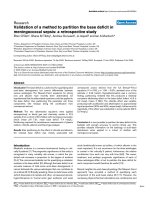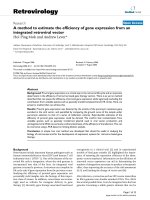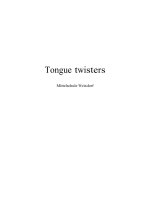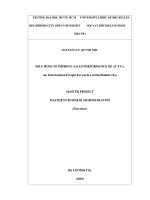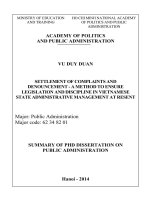Exact modeling of multiple access interference, ber derivation and a method to improve the performance of UWB communication systems
Bạn đang xem bản rút gọn của tài liệu. Xem và tải ngay bản đầy đủ của tài liệu tại đây (768.86 KB, 104 trang )
EXACT MODELING OF MULTIPLE ACCESS
INTERFERENCE, BER DERIVATION AND A METHOD
TO IMPROVE THE PERFORMANCE OF UWB
COMMUNICATION SYSTEMS
SOMASUNDARAM NIRANJAYAN
(B.Sc.Eng (Hons.) , University of Moratuwa)
A THESIS SUBMITTED
FOR THE DEGREE OF MASTER OF ENGINEERING
DEPARTMENT OF ELECTRICAL AND COMPUTER ENGINEERING
NATIONAL UNIVERSITY OF SINGAPORE
2004
ACKNOWLEDGEMENT
I devote my special thanks to my mentors Dr. A. Nallanathan and Dr. B.
Kannan for their continuous encouragement, support and guidance. Their support
extended beyond work, as and when it was needed and helped me to start my
professional life in an enlightened path. I am grateful to Institute for Infocom Research
(I2R) and Dr. B. Kannan for providing me the financial support and resources
throughout the course and for National University of Singapore (NUS) for giving me
an opportunity to take up this research project.
I was fortunate to meet and have the friendship of Mahinthan, Suthaharan and
Sasiri Yapa in these two years, their friendship made life easy and enjoyable.
I would like to thank my parents, brothers and close friends for their inspiration
and encouragement. And, I also like to express my thanks to the four teachers whom I
always remember in my life.
Finally, and most importantly, I dedicate my gratitude for my wonderful wife
Premila who has sacrificed many things than I ever did, to support me in this mission.
Without her moral support, encouragement, cheer-up, and prayers, I would have never
been able to accomplish this.
i
TABLE OF CONTENTS
Acknowledgements
Table of contents
Summary
List of figures
Nomenclature
CHAPTER 1
CHAPTER 2
CHAPTER 3
i
ii
v
vii
ix
INTRODUCTION
1
1.1 Concept and Motivation of UWB Communication
1.2 Motivation for this research
1.3 Contributions of this thesis
1
2
4
SYSTEM AND CHANNEL MODELS
7
2.1 System Models
2.1.1 TH-PPM System
2.1.2 TH-PAM System
2.1.3 DS-PAM System
2.2 Channel model
7
7
10
11
12
EXACT PERFORMANCE ANALYSIS IN
AWGN CHANNELS
15
3.1 Introduction and motivation
3.2 Multiple access interference model
3.2.1 Modeling of τ
3.2.2 TH-PPM System
3.2.3 TH-PAM System
3.2.4 DS-PAM System
3.2.5 Deriving the probability functions
3.2.5.1 For TH-PPM
3.2.5.2 For TH-PAM
15
18
18
21
23
24
25
26
27
ii
3.2.5.3 For DS-PAM
3.3 Derivation of CF and BER in AWGN channels
CHAPTER 4
CHAPTER 5
28
29
3.3.1 TH- PPM
29
3.3.2 TH-PAM
32
3.3.3 DS-PAM
33
3.4 Numerical results
34
3.5 Conclusion
38
PERFORMANCE ANALYSIS IN FADING
CHANNELS
39
4.1 Simplified channel model
4.2 The CF based approach
4.3 A Multi-segmented numerical approach for the
evaluation of characteristic function
4.4 CF of the Total Interference
4.5 The BER probabilities of a correlator receiver
4.6 Numerical results
39
39
43
45
46
47
PERFORMANCE OF M-ARY TH-PAM/PPM
SCHEMES
49
5.1 M-Ary System model
5.1.1 M-ary TH-PAM
5.1.2 M-ary TH-PPM
5.2 Multiple access interference model
5.3 Derivation of the CF and SER
5.3.1 M-ary TH-PAM
5.3.1 M-ary TH-PPM
5.4 Numerical results
5.5 Conclusion
49
49
50
51
54
54
56
58
59
iii
CHAPTER 6
CHAPTER 7
REFERENCES
PERFORMANCE IMPROVEMENT BY AN
ADAPTIVE TRANSMIT ARRAY
60
6.1 Introduction
6.2 Coherent combining
6.3 Coherent combining TH-PPM array
6.4 Performance in AWGN channel
6.5 Multi user performance in multipath fading channel
6.5.1 Detection using a single correlator receiver
6.5.2 Detection by RAKE reception after
coherent combining
6.6 Comparison with receiver diversity
6.7 Variance of the MAI
6.7.1 Proposed scheme
6.7.2 Maximum ratio RAKE combiner
6.7.3 Multi Rx scheme
6.8 Simulation results
6.9 Conclusion
60
62
63
65
66
66
68
69
70
71
72
73
73
78
CONCLUSION AND FUTURE WORK
80
7.1 Conclusions
7.2 Future works
80
82
85
iv
SUMMARY
Impulse radio is an ultra wideband technique that uses a sequence of sub nanosecond
pulses to carry the data. Modulation is achieved by pulse position modulation, pulse
amplitude modulation or on-off keying using many pulses per symbol. Multiple access
capability is achieved using either direct sequence or time hopping technique. Due to
the ability to penetrate through materials and the high resolvability of multipaths with
path differential delays on the order of nanoseconds, this technique has greatly
attracted the research community recently as a promising candidate for high speed,
short range indoor wireless communications. Lack of significant multipath fading
helps reducing the fading margins and hence allows low power operation. Therefore,
low-cost, low-power and simple transceivers are viable using UWB-IR. And the low
power spectral density brings the advantage of license free operation.
Performance measures in wireless communication systems are important in
planning the system architecture, link budget and in some cases these help even in
choosing the right technology. As far as researchers are concerned, performance
measures are important in evaluating and comparing new and existing technologies to
choose the right candidate for the purpose of implementation or standardization. It is
important to have theoretical tools to evaluate these performance measures accurately,
especially the BER which is often much difficult to evaluate. Pure simulation methods
are often not computationally efficient and not very useful in analyzing the effects of
the system parameters. But, theoretical tools provide a framework to study a system’s
performance with respect to various system parameters.
v
In this thesis, we propose exact statistical models for the multiple access
interferences of various UWB systems in AWGN channel. These models are derived
from basic principles using the geometric properties of UWB-IR signals. We extend
the proposed scheme to derive BERs of UWB-IR system in fading channels. We have
considered both binary and M-ary modulation schemes in this thesis. Various
simulation results are also provided to validate the theoretical results.
We have also proposed a coherent combining technique to improve the
performance of an UWB-IR system and its performance is evaluated by comparing it
with some other existing systems.
vi
LIST OF FIGURES
2.1
Typical TH –UWB signal example with Ns = 4 and N h = 4
2.2
Typical DS-UWB signal example with Ns = 16
3.1
Simulation plot of the distribution of τ for Tc = 4ns , in a channel with poisson
arrivals with an arrival rate equal to 0.0233
3.2
An interfering signal (a) compared against the template wave form (b) of the
desired user with N s = 4 andTc = Tf / 4 for TH-PPM. Shown example is
for Dk −1Dk =01
3.3
An interfering signal (a) compared against the template wave form (b) of the
desired user with N s = 4 andTc = Tf / 4 for TH-PAM
3.4
An interfering signal (a) compared against the template wave form (b) of the
desired user with N s = 16 for DS-PAM
3.5
(a) The first template pulse in the template wave form for PPM (enlarged). (b)
The first template pulse in the template wave form of PAM signal (enlarged)
3.6
Theoretical and simulation performance of TH-PPM compared for Ns = 4 and
N s = 8 , with Tc = 8ns and δ = 1.5ns
3.7
Theoretical and simulation performance of TH-PPM compared for Ns = 4 and
N s = 8 , withTc = 2ns and δ = 0.135ns
3.8
Theoretical and simulation performance of TH-PAM compared for Ns = 4
and Ns = 8 , with Tc = 8ns (widely spaced chips)
3.9
Theoretical and simulation performance of TH-PAM compared for Ns = 4
and Ns = 8 , withTc = 2ns (closely spaced chips)
3.10 Theoretical and simulation performance of DS-PAM compared for Ns = 4
and Ns = 8 , withTc = 2ns
4.1
Fading channel performance comparison of theoretical and simulation results
5.1
An interfering signal (a) compared against the template waveform (b) of the
desired user with N f = 4 and Tc = Tf / 4 for M-ary TH-PAM
5.2
An interfering signal (a) compared against the template waveform (b) of the
desired user with N f = 4 and Tc = Tf / 4 for M-ary TH-PPM
5.3
A sample mono-pulse waveform of the M-ary template pulse
vii
5.4
Performance of M-ary TH-PAM depicted for N s = 8 , with Tc / log2 (M ) = 2ns
and δ = 0.135ns
5.5
Performance of M-ary TH-PPM using the upper bound probality, depicted
for N s = 8 , with Tc / log2 (M ) = 2ns and δ = 0.135ns
6.1
Signals before coherent combining
6.2
Signals after coherent combining
6.3
Block diagram of the coherent combining transmit array
6.4
Proposed scheme and RAKE receiver compared in single user environment, ( r number of rake fingers)
6.5
Proposed scheme and RAKE receiver compared in multi user environment, ( r number of RAKE fingers)
6.6
Performance of coherent combining with RAKE reception in single user
environment
6.7
Performance of coherent combining with RAKE reception in multi user
environment
6.8
Performance of multi-RX antennas compared with coherent combining in single
user environment
6.9
Performance of multi-RX antennas compared with coherent combining in multi
user environment
viii
NOMENCLATURE
AWGN
Additive White Gaussian Noise
BER
Bit Error Rate
CDF
Cumulative Distribution Function
CF
Characteristic Function
CLT
Central Limit Theorem
DS
Direct Sequence
DS-PAM
Direct Sequence Pulse Amplitude Modulation
FCC
Federal Communications Commission
FF
Flat Fading
GA
Gaussian Approximation
GQR
Gaussian Quadrature Rule
IEEE
Institute of Electrical and Electronics Engineers
IR
Impulse Radio
MAI
Multiple Access Interference
M-PAM
M-ary pulse Pulse Amplitude Modulation
MPI
Multipath Interference
M-PPM
M-ary pulse Position Modulation
MRC
Maximal Ratio Combiner
OOK
On Off Keying
PAM
Pulse Amplitude Modulation
Probability Density Function
PDP
Power Decay Profile
ix
PPM
Pulse Position Modulation
RX
Receiver
SER
Symbol Error Rate
SIR
Signal to Interference Ratio
SNR
Signal to Noise Ratio
S-RAKE
Selective Rake receiver
TH
Time Hopping
TH-PAM
Time Hopping Pulse Amplitude Modulation
TH-PPM
Time Hopping Pulse Position Modulation
TX
Transmitter
UWB
Ultra Wide Band
WPAN
Wireless Personal Area Network
x
CHAPTER 1
INTRODUCTION
This chapter begins with a brief introduction to ultra-wideband spread spectrum
impulse radio, its advantages and applications. It then describes the motivation for this
work and then summarizes the contributions of this thesis.
1.1 Concept and Motivation of UWB communication
High speed multiple access communication over short ranges faces the challenge of
multipath fading in indoor wireless channels. Instead of increasing the transmit power,
increasing the signal bandwidth to achieve frequency diversity is another way of
mitigating the fading effect, [1].
Using sub-nanosecond baseband pulses is a technique to broaden the signal
bandwidth. The impulse radio uses this technique to spread the signal energy from near
d.c. to a few Gigahertzes [2]. Due to its larger bandwidth the impulsive signal achieve
two important qualities, one is the ability to penetrate through materials and the other
is the high resolvability of multipaths with path differential delays on the order of
nanoseconds [3-4]. Lack of significant multipath fading helps reducing the fading
margins and hence allows low transmission-power operation. This carrier-less pulse
transmission and low transmission power requirement makes low-cost, low-power and
simple transceivers viable using UWB-IR [3]. Furthermore, low transmission power
and large bandwidth yield very low transmitted power spectral density. Hence, the
1
interference to the existing narrowband systems from a UWB device can be reduced
significantly [4].
According to the definition of Federal Communications Commission (FCC), USA,
a system is characterized as ultra-wideband if the fractional bandwidth η ≥ 0.25 ; the
fractional bandwidth is defined by
η=
2 ( fH − fL )
fH + fL
(1.1)
where fH and fL are the upper and lower 10dB points of the spectrum respectively. If
the center frequency is greater than 6GHz, then the system should have a 10-dB
bandwidth larger than or equal to 1.5GHz [5].
In the recent years, UWB-IR is identified as a promising candidate for high speed,
short range indoor wireless communications [6-8] and it has created great interest in
both academia and industry. Due to the nature of the UWB signal it has applications in
areas like, radar imaging, stealth communication, wireless personal area networks
(WPANs) , security and defense, positioning and location, vehicular radar systems and
intelligent transport.
1.2 Motivation for this research
With the increasing number of wireless technologies and increasing customer
expectations and needs in communication, one of the important considerations is the
quality of performance that these techniques can deliver in a channel with many
impairments. These impairments include thermal noise, fading and shadowing,
multiple access interference and interference from external sources. Calculating the
2
performance measures and adjusting the system parameters in order to optimize
various factors like performance, cost, and resource usage are the continuous tasks of
communication engineers. Such performance measures are important in planning the
system architecture, link budget and in some cases it helps even in choosing the right
technology. As far as researchers are concerned, performance measures are important
in evaluating and comparing new and existing technologies to choose the right
candidate for the purpose of implementation or standardization.
Different performance measures are available to evaluate communication systems,
with different levels of ease of evaluation and significance. Firstly, the most common,
mostly understood and perhaps the easiest measure is the signal to noise ratio (SNR).
Often it is defined at the output of the receiver to give a meaningful representation of
the systems ability to recover the information successfully. In fading channels, where
the instantaneous SNR is a random variable, the average SNR is used as the measure.
Another standard measure in fading channels is the outage probability, which is the
probability that the instantaneous error rate is higher than a predefined threshold value.
Another measure is the interference rejection ratio which is a measure of system’s
ability to fight interference. Finally, the most commonly used measure is the bit error
rate (BER), which is more informative about a system’s capability.
It is important to have theoretical tools to evaluate these performance measures
accurately, especially the BER which is often much difficult to evaluate. Pure
simulation methods are often not computationally efficient and not very useful in
analyzing the effects of the system parameters. But, theoretical tools provide a
framework to study a systems performance with respect to various system parameters.
3
Apart from the problem of performance evaluation, another important issue is
performance improvement under the effect of channel impairments. Researchers often
try to come out with solutions that can improve the performance, reduce the
complexity and cost, and optimize power consumption.
1.3 Contributions of this thesis
This thesis is arranged into 7 chapters, where chapters 3, 4, 5 and 6 are the
contributions from this research work. Each of these chapters addresses different
problems. Therefore, in order to improve readability, the first section of each chapter is
devoted to relevant literature review and introduction.
Chapter 2 describes the signal and channel model used, which develops the
framework for the following chapters. It presents the transmitted signal model and
receiver signal processing for binary TH-PPM, TH-PAM and DS-PAM systems.
Chapter 3 presents an exact theoretical model for the MAI in AWGN channels for
different UWB-IRs: TH-PPM, TH-PAM and DS-PAM. It also presents the derivation
of exact BER for these systems based on the proposed MAI model. The BER formulas
are verified by simulation results.
In chapter 4, BER of a TH-PPM UWB system in multipath fading channel is
derived for a single correlator receiver. The MAI model in chapter 3 is used as a basis
to derive the CF of the MAI in fading channels.
A
new
form
of
numerical
approximation for the CF of a lognormal variable is used to derive the CF of the total
interference.
4
Throughout chapter 3 and chapter 4, the performance of binary modulation is
considered. In chapter 5 MAI models are derived for M-ary TH-PPM and TH-PAM
systems. Based on these models, SER and an upper bound for the SER are derived for
TH-PAM and TH-PPM systems respectively.
Chapter 6 presents a novel adaptive transmit array technique to improve the UWBIR performance in multipath fading channels. It then performs a comparison of this
scheme with receiver diversity and analyses the possible use of Rake reception with
the proposed technique. The proposed technique is based on coherent combining of
electromagnetic signals in space, which improves the SNR significantly.
Finally, the conclusions, remarks and few suggestions for future research work are
presented in chapter 7.
The outputs from this work can be found in the following publications:
[1] S. Niranjayan, A. Nallanathan and B. Kannan, “An Adaptive Transmit Diversity
Scheme Based on Spatial Signal Combining for TH-PPM UWB”, Proc. Of
ISSSTA 2004, Aug 2004.
[2] S. Niranjayan, A. Nallanathan and B. Kannan, “Delay Tuning Based Transmit
Diversity Scheme for TH-PPM UWB: Performance with RAKE Reception and
Comparison with Multi RX Schemes”, Proc. of Joint UWBST and IWUWBS
2004, May 2004.
5
[3] S. Niranjayan, A. Nallanathan and B. Kannan, “A New Analytical Method for
Exact Bit Error Rate Computation of TH-PPM UWB Multiple Access Systems”,
Proc. Of PIMRC 2004, September 2004.
[4] S. Niranjayan, A. Nallanathan and B. Kannan, “Exact Modeling of Multiple
Access Interference and BER Derivation for TH-PPM UWB”, WCNC 2005,
Accepted for publication.
[5] S. Niranjayan, A. Nallanathan and B. Kannan, “Modeling of Multiple Access
Interference and BER Derivation for TH and DS UWB Multiple Access
Systems”, IEEE Transactions on Wireless communications, Aug. 2004.
Submitted.
[6] S. Niranjayan, A. Nallanathan and B. Kannan, “Modeling of Multiple Access
Interference and SER Derivation for M-ary TH-PAM /PPM UWB Systems”,
VTC Spring 2005, Accepted for publication.
6
CHAPTER 2
SYSTEM AND CHANNEL MODELS
This chapter discusses the signal models and receiver signal processing for TH-PPM,
TH-PAM and DS-PAM UWB impulse radios, and the channel model used in this
thesis.
2.1 System Models
The IR signal consists of a sequence of mono-pulses, where the multiple access
technique can be time hopping (TH) or direct sequence (DS). And, different
modulation techniques like PPM, PAM and OOK can be equipped to encode the data
on to the pulse sequence. The mono-pulse is a sub nanosecond impulse signal
satisfying the spectral requirements set by the regulatory bodies (eg. FCC’s spectral
mask).
2.1.1 TH-PPM System
In TH technique a sequences of N s mono-pulses are used to carry the bit
information. Each bit duration Tb is divided into N s frames of lengthTf . Each of these
frames contains a mono-pulse and the users are identified by the placement pattern of
mono-pulses within these frames. Each user u has a unique hopping code C u which
defines this placement pattern, where the i th element of C u is an integer value such
that C iu ∈ {0,1,.....N h − 1} . The i th mono-pulse will be offset from the starting of the
i th frame by C iuTc , where Tc is the hopping step.
7
N sTf
Tc
Tf
Fig. 2.1 Typical TH –UWB signal example with
Ns = 4 and N h = 4 .
If PPM is employed to encode the binary data, the transmitted signal of the u th user
can be written as
vu (t )PPM =
∞
E
∑ w [t − iT
f
i =0
− C iuTc − δD u⎣⎢i / Ns ⎦⎥ ]
(2.1)
where δ is the PPM modulation index and D ju ∈ {0,1} is a random variable
representing the j th transmitted binary data of user u . Here, D u⎢⎣i / Ns ⎥⎦ represents the data
bit over the i th frame and ⎣ ⎦ - represents the flooring operator. w(t ) defines the basic
shape of the mono-pulse waveform after modified by the channel and the antenna. The
energy of one mono-pulse is given by
that,
∫
∞
−∞
E
and for simplicity w(t ) is normalized such
w(t )2 dt = 1 .
A generalized multipath channel model can be expressed by the discrete channel
impulse response
L−1
h(t ) = ∑ h lu δ(t − τlu )
(2.2)
l =0
where h lu is the channel gain and τlu is the total delay of the l th signal path of user u .
The total delay consists of the path delays and the asynchronous access delays between
users.
8
Therefore the received signal is given by
r (t )PPM =
Nu −1 L−1
∑ ∑h
u
l u
u =0 l =0
v (t − τlu )PPM + n (t )
(2.3)
where L is the number of significant energy paths, determination of which is based on
the channel model adopted. And, n (t ) represents the additive white Gaussian noise
(AWGN) signal.
Typically the receiver employs RAKE fingers to extract the energy from the
multipath components. Each RAKE finger will have a correlator synchronized to a
particular path. Since the signal processing in each finger is identical, it is enough
presenting the structure of a single correlator receiver. Extending it to the RAKE
receiver is instrumental. The correlating template waveform used for the detection of
the j th bit of the 0th (desired) user is given by
bT (t )PPM =
( j +1)N s −1
∑ b (t − iT
f
− C i0Tc ) ,
(2.4)
i = jN s
where
b(t ) = w(t ) − w(t − δ) .
(2.5)
The decision variable at the output of the correlator detector, which extracts the
energy from the first path, is given by
( j +1)Tb
rPPM =
∫
h 00bT (t − τ 00 )PPM r (t )PPM dt = s PPM + I PPM + n PPM
(2.6)
jTb
where Tb = N sTf is the symbol period, n PPM is the filtered noise and s PPM is the
2
∞
desired signal component where, s PPM = (h00 ) (−1) j N s E ∫ w (t )b (t )dt .
D0
−∞
9
The MAI component I PPM is given by
( j +1)Tb
∫
I PPM =
h 00 bT (t − τ 00 )PPM
N u −1
L−1
u =0
l =0
l =1 if u =0
jTb
∑ ∑
h luvu (t − τlu )dt .
(2.7)
Finally, the decision rule used by the detector is
⎪⎧D j = 0 ⇔ rPPM > 0
" Decide " ⎪⎨
.
⎪⎪D j = 1 ⇔ rPPM < 0
⎩
(2.8)
2.1.2 TH-PAM System
In a binary TH-PAM system the data is encoded on to the pulse stream by inverting
the polarity of the pulses whenever a bit ‘1’ is transmitted. Using the same notations as
in TH-PPM, the TH-PAM transmitted signal can be written as
vu (t )PAM =
∞
E
D u⎢i / Ns ⎥
∑ (−1)
⎣
⎦
w [t − iTf − C iuTc ] .
(2.9)
i =0
For the channel impulse response in (2.2) the received signal can be written as
r (t )PAM =
Nu −1 L−1
∑ ∑h
u
l u
u =0 l =0
v (t − τlu )PAM + n (t ) .
(2.10)
The PAM template waveform for the detection of the j th bit of the 0th user becomes
bT (t )PAM =
( j +1)N s −1
∑
w (t − iTf − C i0Tc ) .
(2.11)
i = jN s
Considering that the detection is done by extracting the energy from the first arrival
path, the decision variable is given by
( j +1)Tb
rPAM =
∫
h00bT (t − τ 00 )PAM × r (t )PAM dt = s PAM + I PAM + n PAM ,
(2.12)
jTb
where the MAI term I PAM is given by
10
( j +1)Tb
I PAM =
∫
N u −1
L−1
u =0
l =0
l =1 if u =0
∑ ∑
h 00 bT (t − τ10 )PAM
jTb
2
h luvu (t − τlu )PAM dt .
(2.13)
The signal component s PAM is equal to (h00 ) (−1) j N s E and the decision rule is
D0
equal to that of the PPM case.
2.1.3 DS-PAM System
In DS-PAM each bit interval is divided in to N s chips of lengthTc . Each chip will
have a mono-pulse weighted by aiu ∈ {±1} which represents the spreading sequence
assigned to user u . Using similar notations a binary DS-PAM signal can be expressed
as
vu (t )DS −PAM =
D⎢ui / Ns ⎥
E (−1)
⎣
⎦
∞
∑ a w [t − iT ] ,
u
i
c
(2.14)
i =0
where Tb = N sTc is the bit interval. Modulation is achieved by multiplying the pulse
stream over a bit interval by either 1 or -1 to represent bits 0 or 1 respectively.
N sTc
Tc
Fig. 2.2 Typical DS-UWB signal example with
N s = 16 .
Now the received signal is given by
r (t )DS −PAM =
Nu −1 L−1
∑ ∑h
u =0 l =0
u
l u
v (t − τlu )DS −PAM + n (t ) .
(2.15)
11
Corresponding template waveform of the correlator detector to detect the j th bit of the
0th user is given by
( j +1)Ns −1
bT (t )DS −PAM =
∑
ai0w [t − iTc ] .
(2.16)
i = jN s
Therefore the decision variable is given by
( j +1)Tb
rDS −PAM =
∫
h00bT (t − τ 00 )DS −PAM r (t )DS −PAM dt = s DS −PAM + I DS −PAM + n DS −PAM , (2.17)
jTb
where the interference term I DS −PAM can be expressed as
( j +1)Tb
I DS −PAM =
∫
h 00 bT (t − τ10 )DS −PAM
jTb
N u −1
L−1
u =0
l =0
l =1 if u =0
∑ ∑
h luvu (t − τlu )DS −PAM dt .
(2.18)
s DS −PAM is equivalent to s PAM and the decision rule for DS-PAM is given by
⎧D j = 0 ⇔ rDS −PAM > 0
⎪
" Decide " ⎪⎨
.
⎪
D j = 1 ⇔ rDS −PAM < 0
⎪
⎩
(2.19)
2.2 Channel model
The channel model in [9,10] has been recommended by the standardization group,
IEEE 802.15.3a, as the model for the evaluation of the proposals for UWB
standardization activities. We make use of this channel model and in some cases we
simplify the model to have closed form solutions. UWB indoor propagation studies
show that the multipath arrivals are clustered rather than in a continuum [9-11]. These
clusters are resulting from the larger structural variations of the building, whereas the
rays within a cluster are from smaller variations [11]. In order to reflect this clustering
phenomenon, the popular Saleh-Valenzuela (S-V) model [12] is used as the basis for
the IEEE802.15.3a channel characterization activities. However, slight modifications
12
are needed since the original S-V model considers a comparatively lower bandwidth
channel which is on the order of 100MHz.
The multipath gain magnitude statistics in a UWB channel is no longer Rayleigh or
Rician as it is the case of narrowband channels in communications. Due to the fine
resolvability, only a few multipath components may overlap within each resolvable
delay bin. Therefore invoking the ‘central limit theorem’ (CLT), which is the basis for
Raileigh and Rician models, is no longer valid. The measurement studies further
confirm this and the gain magnitude statistics is found to follow either a lognormal or
Nakagami distribution [9, 10, 13, 14] . Therefore the IEEE channel model recommends
lognormal distribution to model the multipath gain magnitude. In addition to that,
cluster fading and fading of rays within each cluster are assumed to be independent.
The multipath model consists of the following discrete time impulse response:
K −1 L−1
h (t ) = X ∑ ∑ ψl ,k δ (t − Tk − Tl ,k )
(2.20)
k =0 l =0
where ψl ,k is the multipath gain coefficient, Tk is the delay of the k th cluster, Tl ,k is
the delay of the l th path within a cluster relative to the first path, X represents the
lognormal shadowing and δ (.) is the Dirac delta function. The arrival times of rays
and clusters are modeled by Poisson processes, thus the distribution of Tk and Tl ,k can
be given by the following conditional density functions,
P (Tk /Tk −1 ) = Λe −Λ(Tk −Tk −1 ),
k>0
(2.21)
P (Tl ,k /Tl −1,k ) = Θe
−Θ(Tl ,k −Tl −1,k )
, l>0
13
where Λ, Θ respectively represent the cluster arrival rate and ray arrival rate. The gain
coefficient ψk ,l has the following definition
ψl ,k = pl ,k ξk βl ,k
ξk βl ,k
In which
(2.22)
follows a lognormal distribution and can be expressed by
(µl ,k +χ1 +χ2 ) / 20
ξk βl ,k = 10
,
where
(
χ1 ∝ N 0, σχ21
)
(
χ2 ∝ N 0, σχ2 2
and
)
are
corresponding to the independent fading on each cluster and ray respectively. The
equiprobable signal inversions are represented by pl ,k ∈ {−1,1} .
2⎤
⎡
The power delay profile can be represented as E ⎢ ξk βl ,k ⎥ =
⎣
⎦
0
0
e −Tk / Γ e
−Tl ,k / θ
where
is the mean energy of the first path of the first cluster and Γ and θ denote the
cluster and ray decay factor respectively. The µl ,k is given by
µl ,k =
10 ln (
0
) − 10Tk / Γ − 10Tl ,k / θ
ln (10)
(σ
−
2
χ1
)
+ σχ2 2 ln (10)
20
.
(2.23)
Since the term X captures the lognormal shadowing of the total multipath energy, the
coefficients
ψk ,l are normalized to unity. The shadowing is characterized by
(
)
20 log10 (X ) ∝ N 0, σX2 where σX is the standard deviation of lognormal shadowing
in dB.
14



